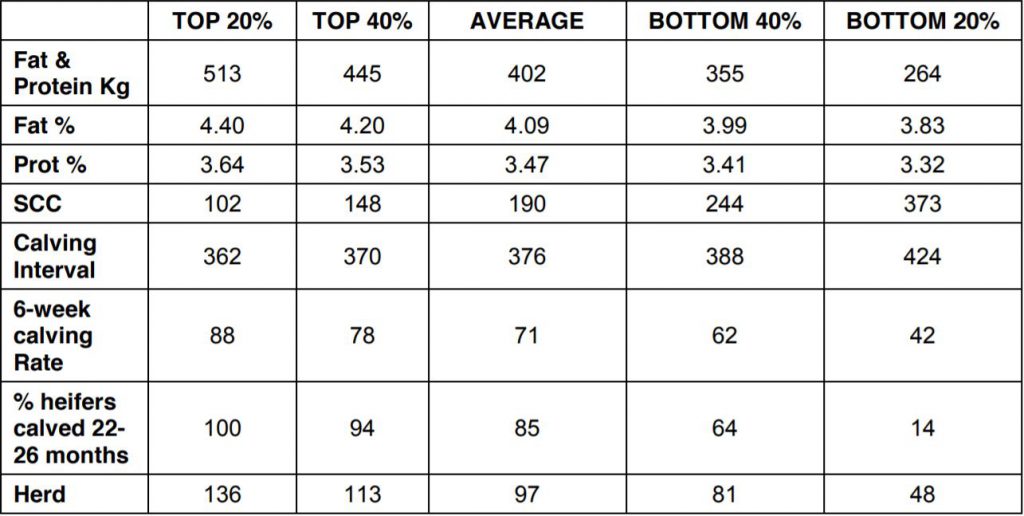There is huge potential at farm level for farmers to increase their profitability by having the right cow for the system, culling the poorest performers and through better on-farm management practices.
This is according to Munster Bovine’s Doreen Corrigan who spoke yesterday, January 8, at the Irish Grassland Association (IGA) dairy conference.
She found, out of the 1,600 herds, the top 25% produce 489kg of MS/cow and the average produced 445kg of MS/cow. Then looking at their cost per cow – in the top 25% – it is €1,114 with the average being €1,188.
She said: “If we take a kilo of milk solids at €4.78, to keep a cow you are talking about 248kg of MS in a low-cost herd. Although in other herds, this is going to be higher, because this is based on these 1,600 herds.
“Some herds could be up to 300kg of MS or could be up to 350kg of MS,” she added.
Analysis of 4,500
She then referred to an analysis of 4,500 spring-calving herds where they looked at all the data from their co-op performance reports.
“We can see that the bottom 20% are just producing 260kg of MS/cow and we saw that it takes 248kg of MS/cow for the cow to pay for herself,” she said.
The analysis also revealed that the bottom 20% of herds had a net profit of €74/cow, compared to €1,227/cow for the top 25% and €941/cow for the average herd owner – completing a Profit Monitor.
She stated: “If we take the milk value at €1,262/cow for the bottom 20%, this leaves the margin per cow at €74 – for a 100-cow herd that is €7,400.
“This margin has to pay the herd owner for the labour, it has to pay the tax and it has to pay the principle back to the bank. When we compared that to the top 20% and 40% we are comparing it to €126,000 and €93,000 respectively.
“High production doesn’t necessarily mean high profitability but we have to hit a certain level,” she added.
Factors influencing output per cow
Advising farmers on ways in which they can improve their milk solids output, she said: “One way is through culling poor performers and the other way is through better on-farm management practices.”
In terms of culling, she said that dairy farmers need to cull poor performers, high somatic cell count (SCC) cows, Johne’s disease positive cows, low-EBI cows and cows with low cows own worth (COW) index values.
She said:
Genetics and EBI are absolutely crucial and if it is not in them to produce it – or they are very low – we can’t inject it into them, so we have to cull them.
“Similarly, high SCC cows will also have to be culled because not only are they poor performers but these cows are also spreading infection to other cows.”
Likewise, she said herd management should be able to correct for herd maturity, days in milk (DIM), heifer rearing and other disease and parasite issues that affect herd performance.
She noted that herd maturity is key because a third lactation cow will throw out 20% more milk than a first lactation cow. “For a herd producing 500kg of MS/cow, you are nearly hitting between €200 and €300 more per cow,” she said.
Days in milk (DIM) was another key aspect she discussed. She said: “Comparing a February and April calver, and all being dried off in December, there is a huge difference of 60 days extra in milk.”
Similarly she said the management and rearing of replacement heifers from birth contributes significantly to their subsequent performance. So good replacement heifer rearing is essential.
In terms of disease, she said most of these can be managed; however, she stressed that “as you go up in herd size you have to increase the spend on health as she said it is a cost you can’t reduce per cow as you go up in herd size”. Liver fluke, she added, has the greatest impact on production.
Should I breed my own replacements?
Continuing, Doreen stated that some dairy farmers are better off sourcing high genetic merit replacements – from high-health status herds – rather than breeding from their own stock.
This, she said, depends on the health status of your herd, the EBI of your herd, the COW values of your herd, the quality of your calf rearing and your calving pattern.
She presented the scenario (below) where the average cows in the low-COW herd were the least profitable in the high-COW herd and the average cows in the high-COW herd were the most profitable in the low-COW herd.
She stated: “Just because you reared her does not mean you should milk her. Ask yourself the question: ‘I have reared her, but should I milk her?’
Outcome
Through culling these ‘problem cows’, Doreen highlighted that profitability will go up.
This, she said, will be because “we are no longer subsidising the unprofitable cows”.
Continuing, she said: “It may also give us the opportunity to a line stocking rate to grass growth; so additional heifers may not need to be purchased.
Labour will be reduced too because we are normally getting rid of problem cows.
“But the biggest benefit is we might get back to having a cubicle per cow.
“If you get back to a cubicle per cow intakes go up, SCC is reduced, immunity goes up – because immunity becomes a big issue in overstocked sheds – production will go up and lameness will be reduced,” she concluded.



